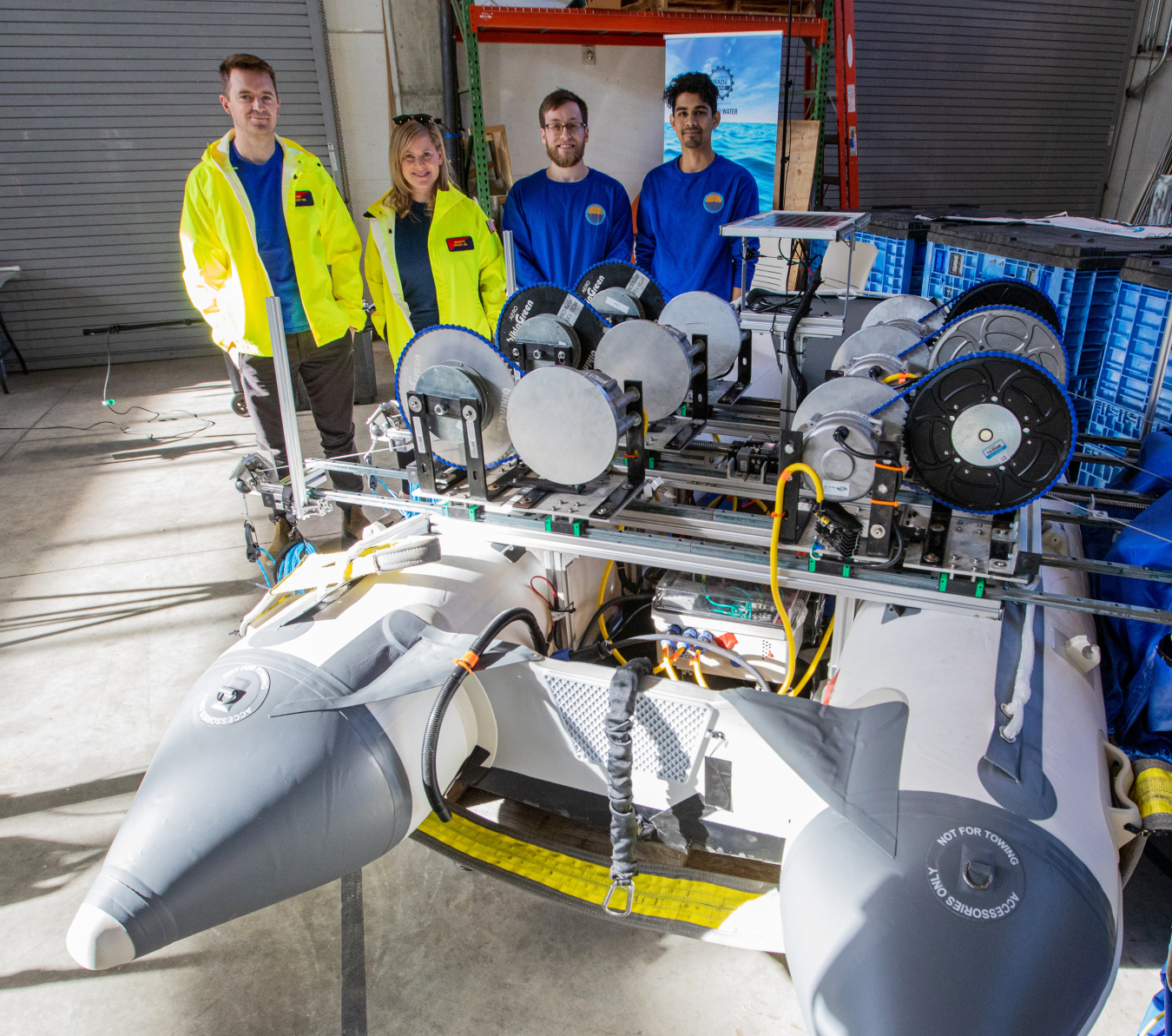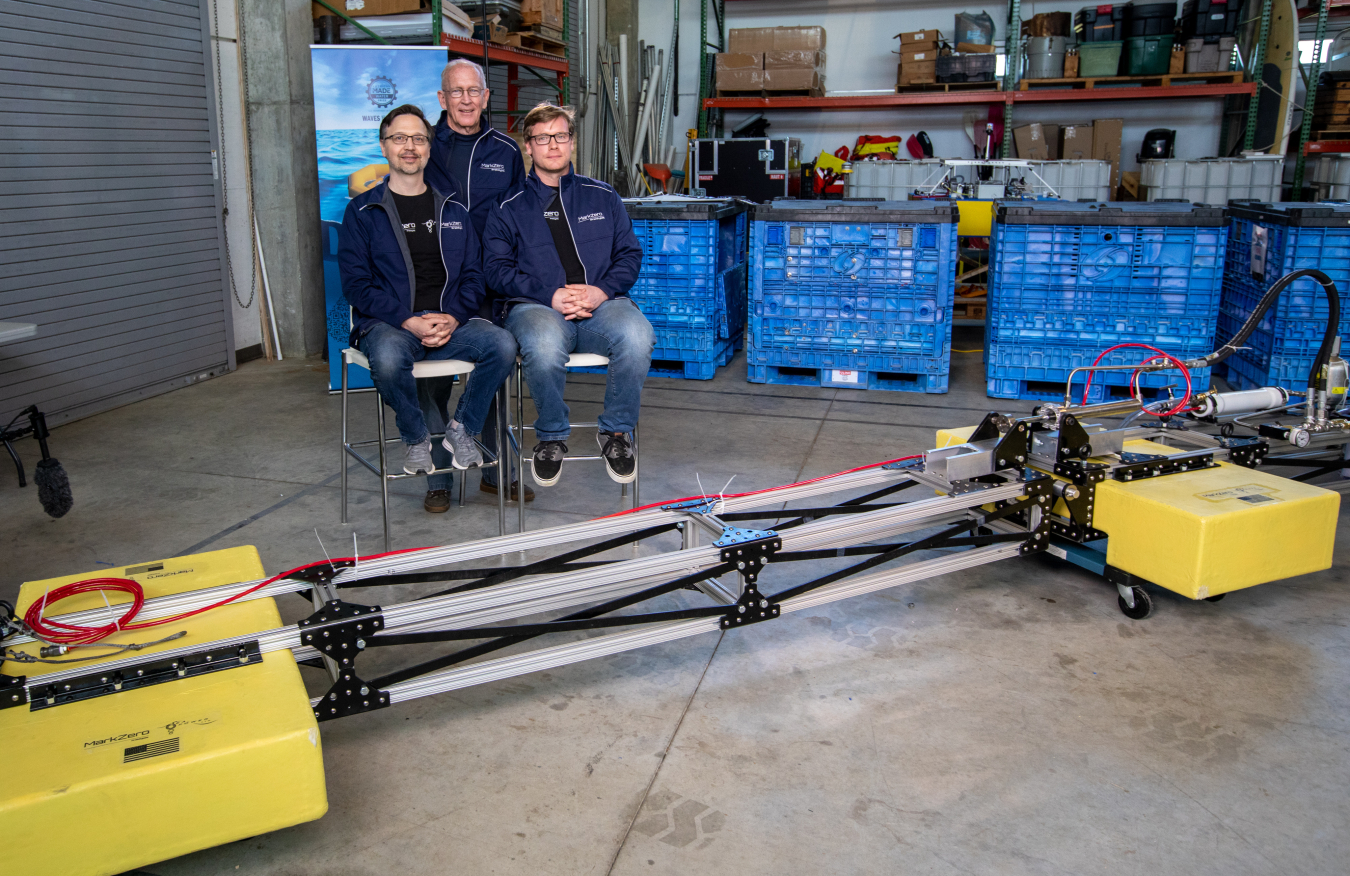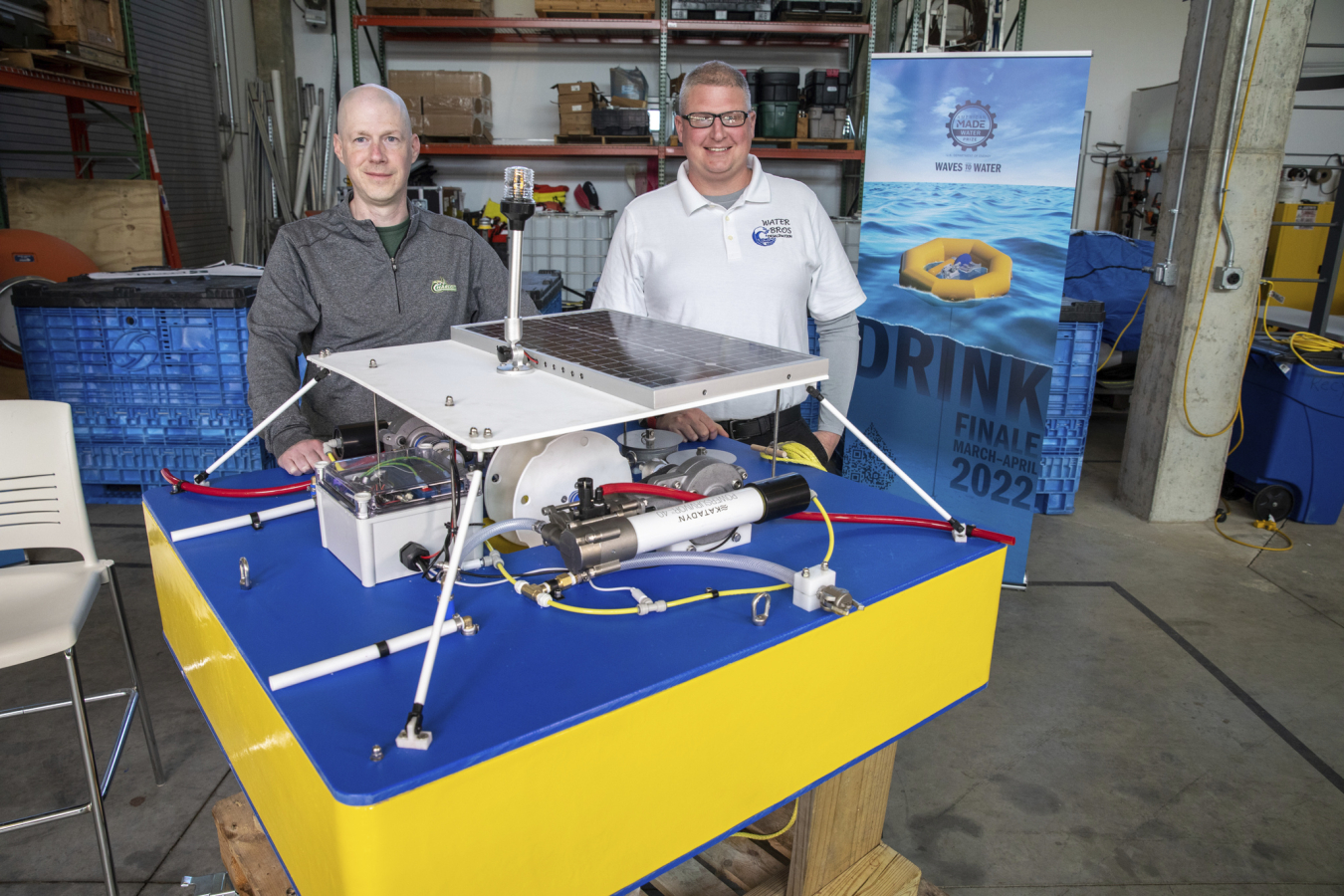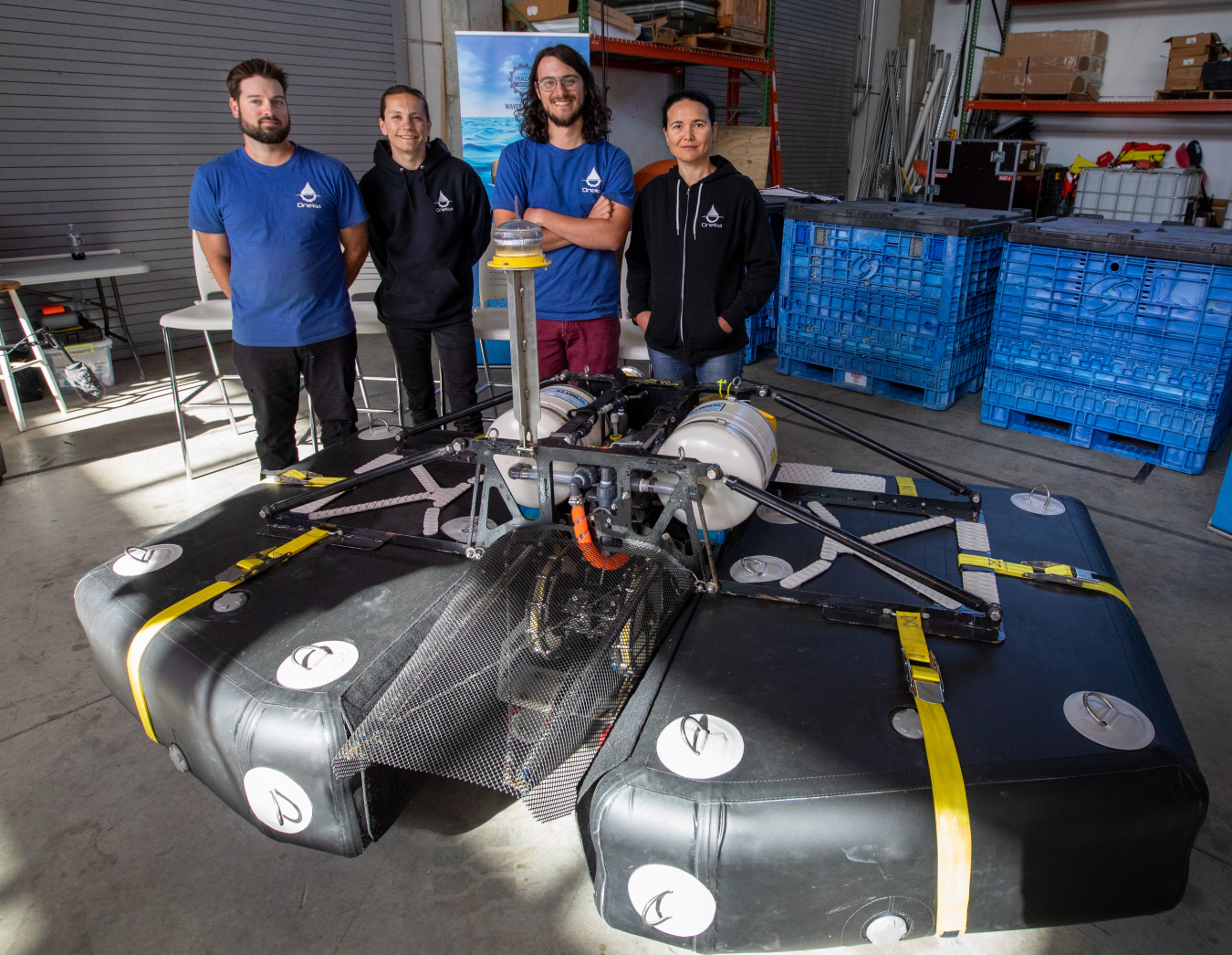Learn what waves have to do with drinking water and what Waves to Water Prize competitors gleaned from testing their small, modular, wave energy-powered desalination prototypes in North Carolina’s Outer Banks.
Water Power Technologies Office
April 6, 2023Water holds an immense amount of energy and an immense amount of potential. For example, the power of ocean waves can be harnessed to make clean drinking water from seawater. The Waves to Water Prize, funded by the U.S. Department of Energy’s (DOE) Water Power Technologies Office (WPTO), sought to better understand this potential by challenging innovators to develop small, modular, wave energy-powered desalination systems.
In April 2022, four teams visited North Carolina’s Outer Banks to deploy their wave-powered desalination prototypes. In the end, all four devices produced desalinated water and weathered the waves of the Atlantic Ocean.
To celebrate the one-year anniversary of the prize’s final event, called the DRINK Finale, WPTO asked the four finalists—Oneka Technologies, WATER BROS, MarkZero SeaPower (MZSP), and Project 816—to reflect on the experiences, impacts, and inspirations the prize ignited. The finalists shared insights from the competition and what they’re doing one year later.
Can you share some information about your organization/company and team?
Oneka Technologies: As a company, Oneka’s mission is to make the ocean a sustainable and affordable source of drinking water. We're headquartered in Canada, but we have an office in Florida as well. We also have a wave-powered desalination system operating in Chile. Dragan Tutic, our CEO and founder, began Oneka in 2015.
WATER BROS: We are a team of marine energy researchers hailing from North Carolina. The Wave-Actuated, Tethered Emergency Response Buoyant Reverse Osmosis System (WATER BROS) was started by Landon Mackey and Wes Williams during the final year of Landon’s Ph.D. studies at North Carolina State University. The team has included a variety of undergraduate and graduate students from the University of North Carolina at Charlotte.
MZSP: MarkZero Prototypes is an engineering firm located in Connecticut that Brandon Poythress founded in 2018. We’re a team of three people, and our main revenue is in industrial and manufacturing automation (so participating in the prize was not our normal thing). For the prize, we partnered with SeaPower, a marine research, development, and engineering company in Ireland to form MZSP.

Project 816: We are a scrappy group of United States Air Force engineers, scientists, and test pilots from Edwards Air Force Base that put our heads together and started Project 816. Our team’s name, Project 816, was inspired by the fact that water is 816 times denser than air. (We thought it was a nice spin since most of the team came from military flight testing.)
Why did you participate in the Waves to Water Prize?
Oneka Technologies: It would have been difficult to find a reason not to participate because wave-powered desalination is the very nature of our organization. However, our team mostly focused on larger, commercial-scale wave-powered desalination units rather than smaller ones. For a long time, we contemplated making a desalination system to produce clean drinking water for emergency relief, but our team never really devoted an effort to it until we saw this prize. So, when the prize opened, we thought, “let's do it now.” In our case, we scaled down our larger technology to fit the competition, and now we have a small-scale unit that can be used for humanitarian and natural disaster relief applications.
WATER BROS: The Waves to Water Prize struck us as a significant and impactful design challenge with the potential to improve the quality of life for millions of people worldwide. There is nothing esoteric about the need for water. We knew of some prior work in the area and felt we had a vision or design outlook that would play well in the competition format.

MZSP: The stars aligned. This competition was so outside of our normal thing, but MarkZero has expertise in naval architecture and mechanical engineering, crucial skills for the prize. We also joined because we knew these people in Ireland who specialized in just wave energy converters. It was a perfect, accidental merging of all the parties, so we figured it’d be silly not to try.
Project 816: We saw this prize competition as an opportunity to solve a real-world problem, using equipment we had in our garages.
How did this prize foster connections (to industry, other competitors, researchers, etc.)? Why are those connections meaningful?
Oneka Technologies: One of the most meaningful connections was with the National Renewable Energy Laboratory technical team and all the feedback they provided along the way to help us fine-tune our system. During the finale, all of the competitors got to know each other better, and it was nice to see everyone working to accomplish the same mission. It was clear that all the teams wanted one another to succeed.

WATER BROS: We stay in touch with Brandon at MarkZero Prototypes, and we recently connected with Oneka at the International Conference on Ocean Energy. We felt a strong sense of camaraderie with all of the competitors in this prize. Ultimately, we aren’t competing with the other teams. We are competing against the ocean. That’s why the connections with other wave energy developers are so natural and genuine... everyone is facing similar challenges, and we’re happy to see progress in the marine energy industry.
MZSP: The biggest connection that came from this prize is our collaboration with WATER BROS. We’ve been working together to eventually take their wave-powered desalination system to the next level in terms of manufacturability, robustness, etc. Long term, we’d be able to help WATER BROS manufacture and produce their device at a larger scale, so that’s the lasting impact of that connection.
Project 816: Our team made all sorts of connections with like-minded people in the marine energy world. Thanks to this prize, we even connected with a national lab to partner with on future grant proposals.
Walk us through the DRINK Finale, the final prize stage. What was it like getting your device into the ocean and seeing it produce desalinated water?

Oneka Technologies: That was a super exciting moment. Our philosophy is that you need to be in the ocean to learn, and the DRINK Finale gave us real-life experience. The exercise was a good testament for our system’s potential because, in the future, this device could be used for emergency relief. So, communities will need to deploy these themselves, and it seems promising that they’ll be able to do that
WATER BROS: The DRINK Stage deployment was a fantastic day. The personnel from the National Renewable Energy Laboratory, Coastal Studies Institute, Jennette’s Pier, DOE, and all the teams collaborated to install the most wave energy converters that had ever been deployed in a single day. It was great to have public involvement and the perfect weather. Even the unfortunate early end to the event due to unpredicted wind gusts helped improve knowledge about wave energy converters by letting us observe differing failure modes amongst the devices.
MZSP: It was so cool. When I stuck my head in the tank and saw there was water, I was so excited. I was worried that something would go wrong and that nothing would happen, and I’d be standing there for five days explaining what went wrong. I remember driving back from North Carolina, and just being super pumped that I did it because we didn’t know if we’d be part of the finale. I’m glad that our device got deployed. I’m glad that it didn’t sink or flip over (at least not that we know of).
Project 816: It was a surreal feeling to see our ideas and our system go from a slide deck to sitting on the waves at Jennette’s Pier. Everyone who had a hand in bringing the prototype to life felt a real sense of excitement.
What wave-powered desalination (or marine energy) work have you been doing since the April 2022 DRINK Finale?
Oneka Technologies: We built and constructed our Iceberg system, which is now deployed in Florida. The Iceberg has the ability to produce about 55 times more desalinated water (8,000-13,000 gallons per day) than the one we built for the prize. We also deployed a smaller system in Chile, which is tethered to the shore and delivers water to a marina (up to 2,600 gallons per day). For the Icecube (another system that is an iteration of the Snowflake design we used in the competition), we are meeting with end users to understand their needs and how we can meet those needs to ultimately commercialize and deploy these smaller systems.
WATER BROS: We've kept our undergraduate students busy this fall and spring, looking at updates to improve our modeling and upgrade our design. These updates and improvements to our wave-powered device focus on better meeting community needs by providing a robust, reliable device that the local community can install and maintain independently. In addition, we’ve attended several conferences to learn from other marine energy researchers and developers.
MZSP: MarkZero put together a preliminary, conceptual design for a turbine-style energy recovery device. Additionally, SeaPower deployed a similar device in the North Atlantic about two months after the prize ended. They are continuing to iterate on the device and will either try to apply for a European Union grant or find an end user for their system.
Project 816: We’ve been focused on advancing our technology and looking to additional funding opportunities to leverage our expertise.
What impact can your device and others like it have on coastal communities, marine energy technologies, or the marine industry as a whole?
Oneka Technologies: Right now, the Icecube system is intended for emergency relief, but as climate change worsens, we want to look beyond temporary solutions. We hope that communities will one day own these systems, building resilience and lessening their dependence on fossil fuels for desalination (and dependence on imported/bottled water). For us, the goal is to develop something that’s more permanent and easier to maintain by using off-the-shelf parts.
WATER BROS: Rural and islanded coastal communities can reap enormous life-enhancing benefits from these systems. Upon further design and testing, the prototypes developed during the Waves to Water Prize can meet the potable water needs of these communities at no energy cost, proving a long-term solution. Through the continued deployment and testing of these devices, marine energy can grow to the same readiness level as wind energy.
MZSP: If we can make these devices more reliable and make reverse osmosis membranes more resilient, then we could deploy these devices in remote areas. And we’d be able to supply water to remote communities.
Project 816: Marine energy can play a critical role in supporting sustainable human presence on Earth. We need to combine marine energy devices with an ocean value chain that is sustainable (e.g., that supports carbon dioxide removal, ocean deacidification, hydrogen/magnesium production, desalination, etc.) in order for these technologies to scale enough to make an impact.
Stay in the know with WPTO! Receive the latest information on funding opportunities, events, and other news by subscribing to the Water Column newsletter, as well as the comprehensive Water Wire newsletter.

